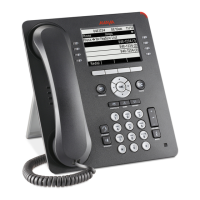About the user interface/failover experience
Issue 3 January 2014 163
● When transition to the secondary server (or back to the primary server) occurs, all
deskphone functionality is restored to normal.
Moving subscriptions occurs immediately after limbo has ended or when there is a graceful
socket closure. For an active call scenario, media preservation will only keep shuffled calls or
calls using direct media between endpoints up with a direct RTP stream until the call has ended.
The user can only put this call on Hold, resume the call, or end the call. The user can also
answer any incoming call and the media preserved call is put on hold. During MSI the user can't
use call related softkeys (Hold, Conf, Transfer) for call appearances or bridged calls and the
softkeys are not removed from the screen. If the user presses another call appearance or a
Favorite Feature an error beep occurs. The Prompt Line displays "Limited phone service". Click
to dial links do not work.
All AST features and BCAs are displayed on the deskphone and SBM24 during MSI regardless
if there is an active call. If a user tries to use an AST feature, the feature fails and the
deskphone displays "Feature invocation failed." When the Phone Button is pressed, the Home
Screen (if there is one) displays instead of the Phone Screen. The user can press the Phone
button to navigate to the Home Screen (if there is one) and all Home Screen sub-screens are
accessible. The deskphone does not block new invites during transition. Changes to
applications other than Contacts, for example, Speed Dial, are cached and are updated by
whichever PPM with which the deskphone successfully registers. Any changes made under the
Avaya menu Options & Settings take place (including the Home Screen) immediately.
If the deskphone is idle when failover occurs and the user presses a call appearance or Favorite
Feature, the deskphone plays an error beep. Going off hook produces no dial tone. The Prompt
Line displays "Limited phone service" and no digits are displayed on the screen. All Home
Screen sub-screens are accessible. The user can access all the web links from any of the
Home Screen options except for a "Click to Dial Link," which produces an error beep if selected.
The Prompt Line displays "Limited phone service" in this case.
During MSI the Contacts button remains activated and the user can view the Contacts Screen.
Contacts can be changed during failover transition up to the maximum cache size regardless of
which primary controller is used. The New, Edit, or Delete softkeys display during failover.
During MSI transition, the +AddtoContact function on a web page will fail and the Prompt Line
will display "Contact cannot be saved." Selecting a contact or pressing the Call softkey
produces an error beep and the Prompt Line displays "Limited phone service."
All screens are visible. Any changes made under the Avaya menu Options & Settings take
place on all screens (including the Home Screen) immediately. All changes other than Contacts
are cached and are updated to the PPM with which the deskphone successfully registers.
All Audio Receive, Transmit, Top Line, Web Push, or phoneXML pushes operate normally.
For incoming calls during MSI, the deskphone stops alerting and disconnects the call. If the
deskphone is alerting when the deskphone's secondary server goes down (no MSI), the
deskphone will keep on ringing. An incoming call will be ended when the link between the
Session Manager that routed the call and the deskphone has gone down. For example, if the
deskphone has a primary Session Manager (Session Manager 1) and a secondary Session
Manager (Session Manager 2), and receives a call directly from the secondary Session
Manager but Session Manager 2 goes down, the call that was received from Session Manager
2 is terminated.

